Range 11,390 km Length 30 m Weight 22,600 kg | Wingspan 29 m Top speed 950 km/h | |
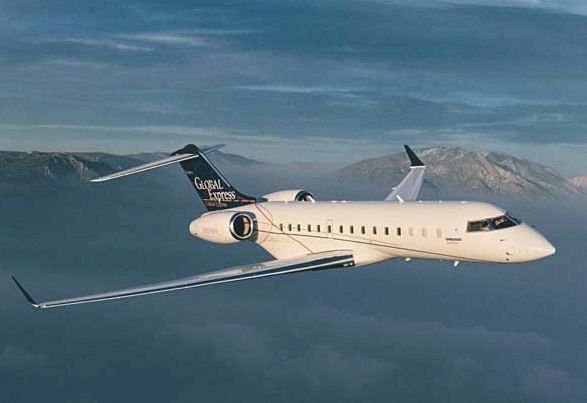 | ||
Engine types Rolls-Royce BR700, Turbofan Manufacturers Bombardier Inc., Bombardier Aerospace | ||
Bombardier global express xrs
The Bombardier Global Express is a large cabin, ultra long range business jet manufactured by Bombardier Aerospace in Toronto, Ontario, Canada. There are currently three variants in active service — the original Global Express, Global 5000 & Global 6000 — and two more under development — the Global 7000 & Global 8000. The Global Express has been modified for military missions, such as the Raytheon Sentinel and the United States Air Force E-11A. The Global Express can fly intercontinental ranges without refuelling (e.g. New York City–Tokyo) or between most two points in the world with only one stop. In this class the Global Express competes with the Airbus Corporate Jet, Boeing Business Jet and Gulfstream G550/650.
Contents
- Bombardier global express xrs
- Design and development
- Global 5000
- Global 6000
- Variants
- Military operators
- Civil operators
- References
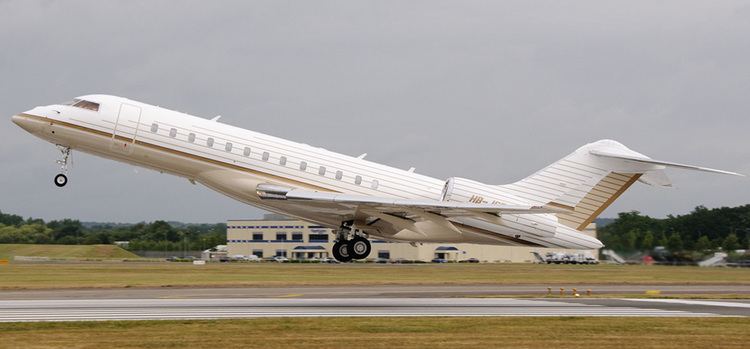
Design and development
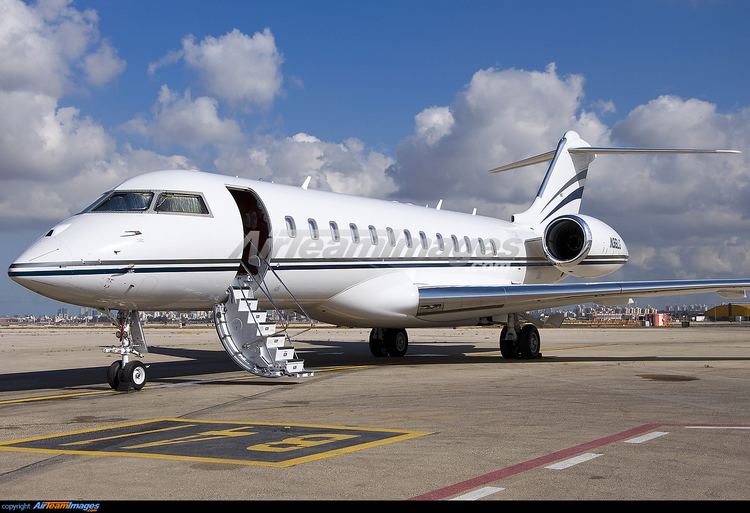
Bombardier Aerospace began studies in 1991 and the aircraft was officially launched in 1993. The first flight occurred on October 13, 1996. The Global Express shares the Canadair / Bombardier Regional Jet's fuselage cross section and is similar in length, but despite the size similarities the two aircraft are very different due to the nature of their roles. The Global Express features an advanced all new supercritical airfoil with a 35° sweep and winglets, plus a new T-tail. The aircraft is powered by two BMW RollsRoyce BR-710 turbofans with FADEC. The advanced flightdeck features a six screen Honeywell Primus 2000 XP EFIS suite and is offered with optional heads-up displays.
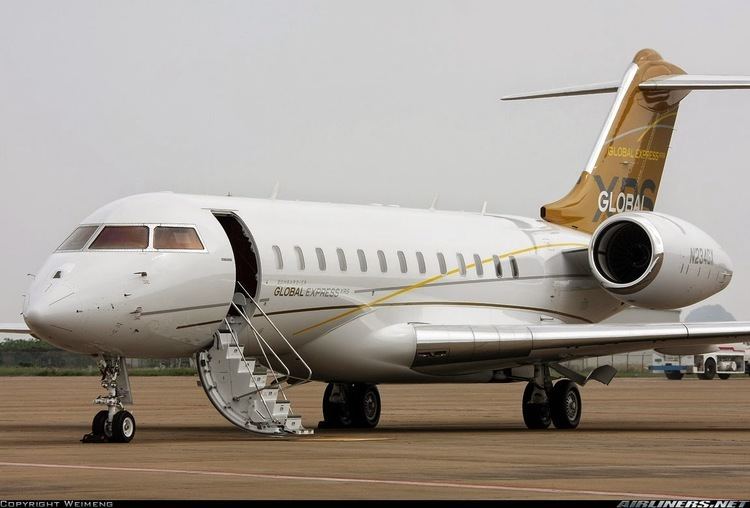
The Global Express was announced on 28 October 1991 at the NBAA convention. Full-scale cabin mockup was exhibited at the NBAA convention in September 1992. Conceptual design started early 1993 and the programme was officially launched on 20 December 1993. The aircraft high-speed configuration was frozen in June 1994 and the low-speed configuration was established in August 1994.
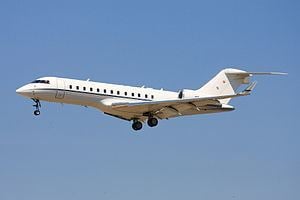
Bombardier subsidiaries have three specific roles in the project: Canadair is the design leader and manufactures the nose; Short Brothers, Belfast, is responsible for the design and manufacture of the engine nacelles, horizontal stabiliser and forward fuselage; and de Havilland Canada builds the rear fuselage and vertical tail and carries out final assembly. The major external supplier is Japan's Mitsubishi Heavy Industries which builds the wing and centre fuselage sections. In 2015, Bombardier announced to reduce production because of lower demand caused by slowing economy and geopolitics in markets such as Latin America, Russia and China.
Global 5000
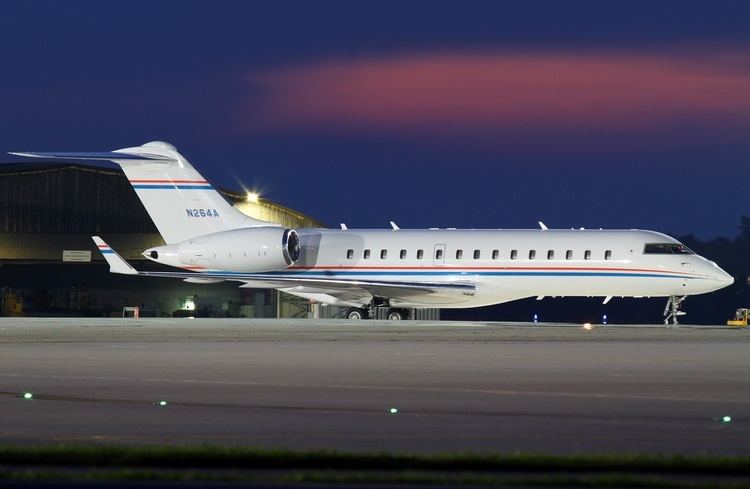
The Global 5000 (model designation BD-700-1A11) is a derivative based on Global Express, with 813 mm (32 in) reduction in forward fuselage length, and 1,200 nmi reduction in maximum range. Seating capacity is up to 19 passengers. The aircraft was announced on 25 October 2001 with the official launch on 5 February 2002, after a positive market assessment with letters of intent for 15 aircraft.
The aircraft is manufactured by Bombardier Aerospace in Toronto, Ontario, and flown "green" to Montreal, Quebec, Savannah, Georgia, or Cahokia, Illinois for final completion.
The Global 5000 is built on the same production line as the Global Express XRS, and the two types' serial numbers are intermingled.
The first Global 5000 aircraft (s/n 9127) flew on 7 March 2003. The flight was dedicated to testing basic system functionality and assessing the aircraft's handling and flying qualities. The aircraft completed its preliminary testing at Bombardier's Downsview facility, before it moved to Bombardier's Wichita facility to begin the flight test program. The Global 5000 made its first appearance at the Paris Air Show in June 2003.
The average trip lengths for most operators is 2.5 hours where the aircraft will cruise between Mach 0.85 and Mach 0.89, making it one of the fastest long range jets available today.
Typical configuration features 18 passenger seats including fully berthable seats and an aft lounge/bedroom. The aircraft has a full galley and two lavatories. The crew rest area was removed, but is being considered on newer versions.
Originally, the maximum takeoff weight was 88,700 lb (40,200 kg). With typical equipment and passenger accoutrements, the empty weight was 52,000–55,000 pounds (22,600–25,000 kg). In April 2008, Bombardier announced that the certified gross weight had been increased to 92,500 lb (41954 kg), which permitted an increased fuel load—projected maximum range increased to 5,200 nmi (9637 km).
The maximum certified altitude is 51,000 ft (16,000 m) The typical approach speed is 108 kn (200 km/h) requiring approximately 2,600 ft (790 m) of runway for landing.
Global 5000 changes compared to the Global Express are:
Global 6000
The Global 6000 (formerly marketed as the Global Express XRS) is an improved version of the original aircraft, (announced on October 6, 2003 during the NBAA Convention at Orlando, Florida) offering higher cruise speed, increased range, improved cabin layout and lighting. Bombardier’s Vision flight deck, powered by Rockwell Collins Pro Line Fusion avionics, is perhaps the biggest upgrade from the XRS to the 6000 and compared to its predecessor, the Global XRS, it has improved acoustical insulation.
The range increase is achieved by addition of a 1,486 lb (674 kg) fuel tank at the wing root. Bombardier claims it takes 15 minutes less to fuel the Global 6000 than the original model thanks to improved computer systems and mechanical refinements. The Global Express 6000 entered service in early 2006. The unit price is estimated to be $US45.5 million.
Variants
Military operators
Civil operators
The aircraft is operated by private individuals, companies, executive charter operators and government agencies.
Vistajet
